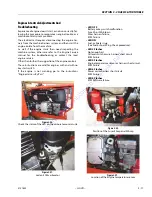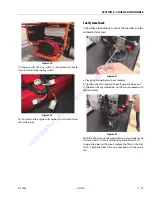
SECTION 3 - CHASSIS & TURNTABLE
3121623
– JLG Lift –
3-9
Transporting Unpacked Slew Drives
Figure 3-20. Use suitable lifting gear/never transport product
vertically
Unpacked slew drives can be transported with lifting gear
when using eye bolts under the following conditions
•
The lifting gear must be configured appropriately for
the weight of the transport units.
•
The ring bolts must be configured appropriately for
the weight of the transport unit.
•
The slew drive shall only be transported by itself, with-
out attached parts.
•
Maintain the insertion depth prescribed by the manu-
facturer.
•
If insertion depth is not prescribed, then a minimum
insertion depth of 1.5 x the bolt diameter must be
selected.
•
Transport within the company shall only be executed
horizontally.
Figure 3-21. Always use the full length of the thread
Attachment:
1.
Screw the 3 eye bolts into the 3 threads that are
distributed uniformly on the circumference of
the slew drive.
SCREW IN THE EYE BOLTS TO THE FULL THREAD LENGTH! IMPROP-
ERLY ATTACHED, UNSUITABLE, OR DAMAGED EYE BOLTS MAY CAUSE
THE SLEW DRIVE TO FALL AND CAUSE LIFE-THREATENING INJURIES.
2.
Attach lifting gear to the eye bolts.
3.
Start the transport.
Positioning The Swing Drive
1.
Determine the main load-carrying zone. The
main load-carrying zone is that area of the slew-
ing ring that is subject to the highest load, tak-
ing all aggressive forces and torques, and all
occurring load cases into account.
2.
Arrange the hardness gap of the bearing ring
charged with point load so that it is offset by 90°
relative to the main load-carrying zone. The
main load- carrying zone is in the main slewing
range.
CAUTION
THE HARDNESS GAP OR THE FILLING PLUG IN A SLEWING RING CON-
STITUTE A ZONE OF DECREASED LOAD-CARRYING CAPACITY. THE SER-
VICE-LIFE OF THE SLEW DRIVE WILL BE REDUCED SIGNIFICANTLY, IF
THE HARDNESS GAP IS IN THE MAIN SLEWING RANGE. FRACTURE OF
BEARING RING FOR EXAMPLE MAY CAUSE SLEW DRIVE FAILURE. CON-
SEQUENTLY PLACE THIS MARKED POINT IN A REDUCED LOAD ZONE IF
POSSIBLE.
3.
Use a feeler gauge to check whether the support
surface of the slew drive is completely sup-
ported by the mounting structure. If this is not
the case, the support surface of the mounting
structure must be reworked.
Figure 3-22. Check the support surface
Go
to
Discount-Equipment.com
to
order
your
parts








































